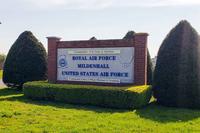Defense Secretary Chuck Hagel phoned his Japanese counterpart Wednesday to bolster their opposition to China's attempts to restrict air traffic over disputed islets in the East China Sea.
Hagel and Japanese Defense Minister Itsunori Onodera also discussed Guam and the long-stalled plan to move several thousand Marines from Okinawa to the U.S. territory as part of the rebalance of U.S. forces to the Pacific.
Two unescorted and unarmed B-52H bombers flying out of Guam's Andersen Air Base on Monday passed through the Air Defense Identification Zone declared by China over a wide area of the East China Sea to include uninhabited islands called the Senkaku by the Japanese and the Diaoyu by China.
The B-52s made no attempt to identify themselves as demanded by the Chinese and returned to Andersen without incident.
On Wednesday, China sought to minimize the flyover while threatening to set up other air identification zones in the South China Sea.
"Relevant countries need not make a fuss, panic or relate themselves to it," Chinese Foreign Ministry spokesman Qin Gang said, according to Beijing's official Xinhua news agency.
The People's Liberation Army monitored the B-52 flights which passed about 150 miles east of the disputed islands, said Chinese Defense Ministry spokesman Geng Yansheng.
"We need to stress that China will identify every aircraft flying in the air defense identification zone," Geng said, adding that "China is capable of exercising effective control over this airspace."
Geng also said that China was considering setting up another identification zone in the South China Sea, Xinhua reported.
In his phone call, Hagel told Onodera that China's effort to control air space was "a potentially destabilizing unilateral action designed to change the status quo in the region, and raises the risk of misunderstanding and miscalculation," according to a readout produced by the Pentagon.
Hagel assured Onodera that "U.S. military operations will not in any way change as a result of China's announcement," and he noted that the pre-planned B-52 flights were unchallenged by the Chinese.
Hagel also re-affirmed U.S. commitment to the Mutual Defense Treaty with Japan which includes the Senkaku Islands, the Pentagon said.
The U.S. defense secretary told Onodera of the need to make progress "on steps to realign U.S. Forces in Japan and mitigate impacts on the people of Okinawa."
Hagel said that moving Marines off Okinawa to Guam was a "top priority" in line with "achieving a force posture that is more geographically distributed, operationally resilient, and politically sustainable."
Funding for the movement of the Marines to Guam has been caught up in a dispute between Congress and the White House over "limitations" on how the money would be spent.
Earlier this month, the Senate Armed Services Committee in the markup of the National Defense Authorization Act moved to "extend prohibitions" on funding for the Guam move until the Defense Department came up with a more detailed plan.
The White House "strongly objected" to the SASC move to restrict "the obligation of funds for the re-alignment of U.S. Marine Corps units from Okinawa to Guam and Hawaii."
"A key aspect of the Asia-Pacific rebalance is to create a more operationally resilient Marine Corps presence in the Pacific and invest in Guam as a joint strategic hub," the White House Office of Management and Budget said in a statement in response to the SASC markup.




























